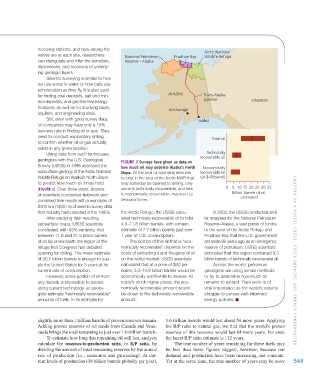Page 550 - Environment: The Science Behind the Stories
P. 550
receiving stations, and how strong the Arctic National
waves are at each site, researchers National Petroleum Prudhoe Bay Wildlife Refuge
can triangulate and infer the densities, Reserve - Alaska
thicknesses, and locations of underly-
ing geologic layers.
Seismic surveying is similar to how
we use sonar in water or how bats use
echolocation as they fly. It is also used
for finding coal deposits, salt and min- ALASKA Trans-Alaska
eral deposits, and geothermal energy pipeline CANADA
hotspots, as well as for studying faults, Anchorage
aquifers, and engineering sites.
Still, even with good survey data, Valdez
oil companies may have only a 10%
success rate in finding oil or gas. They
need to conduct exploratory drilling Total oil
to confirm whether oil or gas actually
exists in any given location.
Using data from such techniques, Technically
geologists with the U.S. Geological FIGURE 2 Surveys have given us data on recoverable oil
Survey (USGS) in 1998 assessed the how much oil may underlie Alaska’s North Economically
subsurface geology of the Arctic National Slope. Of the total oil scientists estimate recoverable oil
Wildlife Refuge on Alaska’s North Slope to exist in the area of the Arctic NWR that (at $40/barrel)
to predict how much oil it may hold may someday be opened to drilling, only
(FIGURE 2). Over three years, dozens some is technically recoverable, and less 0 5 10 15 20 25 30 35
of scientists conducted fieldwork and is economically recoverable. Data from U.S. Billion barrels of oil,
estimated
combined their results with a reanalysis of Geological Survey.
2300 km (1400 mi) of seismic survey data
that industry had collected in the 1980s. the Arctic Refuge, the USGS calcu- In 2002, the USGS conducted simi-
After studying their resulting lated technically recoverable oil to total lar analyses for the National Petroleum
subsurface maps, USGS scientists 4.3–11.8 billion barrels, with a mean Reserve–Alaska, a vast parcel of tundra
concluded, with 95% certainty, that estimate of 7.7 billion barrels (just over to the west of the Arctic Refuge and
between 11.6 and 31.5 billion barrels 1 year of U.S. consumption). Prudhoe Bay that the U.S. government
of oil lay underneath the region of the The portion of this oil that is “eco- set aside 90 years ago as an emergency
refuge that Congress has debated nomically recoverable” depends on the reserve of petroleum. USGS scientists
opening for drilling. The mean estimate costs of extracting it and the price of oil estimated that this region contained 9.3
of 20.7 billion barrels is enough to sup- on the world market. USGS scientists billion barrels of technically recoverable oil. CHAPTER 19 • FOSSIL FUELS, THEIR IMPA CT S, AND ENERGY CONSERVATI ON
ply the United States for 3 years at its calculated that at a price of $40 per Across the world, petroleum
current rate of consumption. barrel, 3.4–10.8 billion barrels would be geologists are using similar methods
However, some portion of oil from economically worthwhile to recover. At to try to determine how much oil
any deposit is impossible to extract today’s much higher prices, the eco- remains to extract. Their work is of
using current technology, so geolo- nomically recoverable amount would vital importance as the world’s nations
gists estimate “technically recoverable” be closer to the technically recoverable struggle to pursue well-informed
amounts of fuels. In its estimate for amount. energy policies.
slightly more than 1 trillion barrels of proven reserves remain. 1.6 trillion barrels would last about 54 more years. Applying
Adding proven reserves of oil sands from Canada and Vene- the R/P ratio to natural gas, we find that the world’s proven
zuela brings the total remaining to just over 1.6 trillion barrels. reserves of this resource would last 64 more years. For coal,
To estimate how long this remaining oil will last, analysts the latest R/P ratio estimate is 112 years.
calculate the reserves-to-production ratio, or R/P ratio, by The true number of years remaining for these fuels may
dividing the amount of total remaining reserves by the annual be less than these figures suggest, however, because our
rate of production (i.e., extraction and processing). At cur- demand and production have been increasing, not constant.
rent levels of production (30 billion barrels globally per year), Yet at the same time, the true number of years may be more 549
M19_WITH7428_05_SE_C19.indd 549 12/12/14 5:23 PM

